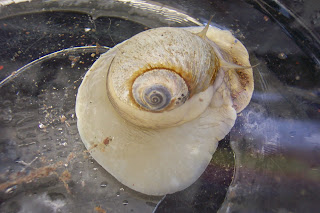Cup-and-saucer limpets (Crucibulum striatum) stuck to rocks and shells brought up from the ocean bottom.
Slipper limpets (Crepidula fornicata) are often found stacked. The largest one on the bottom is female and the smaller ones on top are male. If the female on the bottom dies the largest male will become a female.
The underside of the slipper limpet showing the 'deck' from which the animal gets its common name.
Tortoiseshell limpet (Acmaea testudinalis) on the move in the intertidal zone.
Smooth periwinkles (Littorina obtusata) are usually found amongst knotted wrack on the beach.
Smooth periwinkles can be a variety of colours.
Note how well camouflaged the smooth periwinkles are to match the reproductive receptacles and air bladders of the seaweed.
Rough periwinkles (Littorina saxatilis) are found in the high intertidal zone.
Common periwinkles (Littorina littorea) are the largest and most abundant periwinkle in Passamaquoddy Bay. Their original habitat was Europe but they have been here for over 100 years.
Moon snail (Lunatia heros) are found on muddy beaches and can grow quite large.
The moon snails leave egg collars on the beach.
The spotted moon snail (Lunatia triseriata) is a smaller species than the one above and can be distinguished by bluish or purplish spots on the shell.
The mud dog whelk (Nassarius obsoletus) is found on rare occasions in the intertidal zone.
Waved whelks (Buccinum undatum) and their masses of egg capsules are pulled up in the scallop drag.
Dogwinkles (Thais lapillus) are carnivorous and prey on other intertidal animals such as blue mussels, periwinkles and barnacles as they are doing in this picture.
Dogwinkle eggs as found under a rock on the beach.
The ten-ridged whelk (Neptunea decemostata) is a large snail found on the ocean floor.
The Stimpson's whelk (Colus stimpsoni) is a rare find in the scallop drags.
The rough-mantled nudibranch (Onchidoris bilamellata) is a sea slug.
These shell-less molluscs lay their eggs in ribbons on the underside of rocks in the intertidal zone.
The red-gilled nudibranch (Coryphella rufibranchialis) is a beautiful and delicate sea slug found in the lower intertidal zone.
This scallop (Placopecten magellanicus) is showing off its many eyes.
Scallops are fished commercially in this area and are a favourite at the local restaurants.
Blue mussels (Mytilus edulis) attach tightly to each other using byssal threads, called the beard by mussel lovers.
The horse mussel (Modiolus modiolus) is much larger than the blue mussel and has a brown, flaky covering. Not a commercial species.
The waved astarte (Astarte undata) is a small bivalve we pull up in the scallop drag.
The northern cardita (Cyclocardia borealis) is another small bivalve that lives on the bottom.
The quahog (Mercenaria mercenaria) is easily identified by the purple stain in the shell. Locally, these can only be found in Sam Orr Pond. The latin name is derived from the fact that these shells were used in making Native American money or wampum.
The black clam (Arctica islandica) lives on muddy bottoms.
Soft-shelled clams (Mya arenaria) are dug by clam diggers on the many muddy beaches in our area.
This picture shows the siphon openings of the soft-shelled clam; all that you see when the clam is buried in the mud.
The macoma clam (Macoma balthica) is a small bivalve with a pink interior.
Macoma clam holes on the beach.
The razor clam (Ensis directus) burrows deeply on muddy bottoms in the subtidal zone. Its long foot is used to burrow and swim.
Short-finned squid (Illex illecebrosus) swim in large schools and die after spawning.
Long-finned squid (Loligo pealei) eggs found on the shore.
This octopus (Bathypolypus arcticus) is distinguished by the warty horns above its eyes. They are occasionally collected in our fish trawls in deep water.





































No comments:
Post a Comment